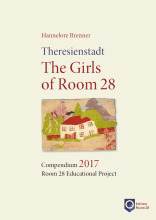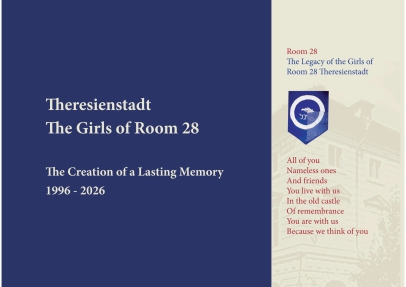Exhibition
The Girls of Room 28, Theresienstadt
December 2025
This site ist for English readers and gives essential information about the Exhibition The Girls of Room 28.
Beginning. Background. Motives.
The exhibition was created to complement the book The Girls of Room 28, first published in April 2004 by Droemer Publishing House, Munich. The idea was to make it easier for the survivors to tell their stories to young people along the panels. This hope was fulfilled. For many years, the survivors accompanied the exhibition and shared their stories with young people all over the country, especially in Germany and the Czech Republic.
Today this is no longer possible. Most survivors are gone. But their legacy lives on—in the publications of Edition Room 28, in the images and testimonies captured in the exhibition, and in the extensive audio and film archive of the author Hannelore Brenner, which is a treasure trove of material waiting to be explored for use in the exhibition and educational project. Her archive is a valuable resource for anyone interested in learning about the experiences and fates of the Girls of Room 28.
Basic Information
Basic information about the exhibition, its motives, aims or venues of the exhibition between 2004 and 2017, can be found in the Compendium 2017, a brochure with 124 pages presenting the Room 28 Educational Project. The pages 12-22 about the exhibition can be downloaded below. If interested in the brochure, let us know.
The chronicle of the venues of the exhibition in this book ends in 2017. So there are more to add today, like the exhibition in the Welsh National Opera House in Cardiff in June 2019 and further exhibitions in Germany.
Steps to a Modern Exhibition. 2026-2027.
Our aim is to maintain and modernise our existing exhibition and continue offering it to schools. Ideally, we would like to build partnerships with schools and educational institutions interested in our exhibition and in our educational project.
Furthermore, we strive to create two new forms for our exhibition:
- An international Online-Exhibition and digital platform for the Room 28 educational project
- A Permanent Exibition devoted to the Legacy of the Girls of Room 28.
Your support is welcome!
We are grateful to those ready to support our work and mission!
Room 28 Audio- and Filmarchive
The author Hannelore Brenner has an extensive media archive with audio recordings/interviews with the survivors of Room 28 and further survivors of Theresienstadt and Auschwitz. These interviews began with her research for the radio-documentary about the children's opera "Brundibár" produced by Sender Freies Berlin in 1997 under the title "Brundibár and the children of Theresienstadt" and a year later by Austrian Radio in Vienna. It was then when the author allied with the group of women who once lived in Room 28 in the Girls' Home L410 together. The interviews were continued till the book came out in 2004. Further film and interview projects followed, all of them forming part of the Room 28 Media Archive.
Highlighting the Authenticity
Many quotes in the book and in the exhibition The Girls of Room 28 come from this precious media-archive. We will explore and digitise it and make it a part of the exhibition and the educational project thus bringing the story to life and
highlighting the special quality and authenticity of this project of remembrance.
The first pages of the Compendium gives an impression of how this project started, sheds light on the work of the author with these women and on their annual meetings in Spindlermühle/Czech Republic starting in September 1998. You are welcome to download these pages.
Existing Short Films
- English film: The Girls of Room 28. Promotionfilm for a planned English documentary. Room 28 Production,15'
- German film: Ich wandre durch Theresienstadt. Auf den Spuren der Mädchen von Zimmer 28. 2009. Room 28 Production, 12'
- German film: Die Mädchen von Zimmer 28. Erinnerungen von Helga Kinsky, Ela Weissberger, Anna Hanusová. Marienbad, September 2010, 15'
- Memory Drops. Film made in Israel by Eliana Schejter and Addie Reiss for Room 28. Hanka Weingarten, Handa Drori, Judith Rosenzweig, Eva Zohar and Vera Kreiner remember Room 28. 2012,12'.
Memory Drops
We share the film Memory Drops with those interested in our project and considering to support our Project of Remembrance and Education.
Educational Value
The project was born out of the genuine desire of the survivors to remember and has grown over a decade into a flame of memory, friendship and hope, kept alive by those who were touched and inspired by their story. It is a story that is more than a chapter of the Holocaust and "More than memories of a dark time", as Professor Peter Gstettner titled his contribution to the Compendium.
We gladly offer you to read his contribution of the Compendium as well as those from Detlef Pech and Bertram Noback, all renowned educational scientists and experts in Holocaust education.
Compendium 2017. Peter Gstettner.pdf
PDF-Dokument [3.4 MB]
Bertram Nobak, teaching memory in the 21[...]
PDF-Dokument [4.4 MB]
Detlef Pech. Memories of human strength.[...]
PDF-Dokument [1.6 MB]
Creating a Lasting Memory...
... this is our goal conveyed in the new brochure that will be ready to ready January 2026. You can read the first 15 pages.
PDF-Dokument [5.5 MB]
















